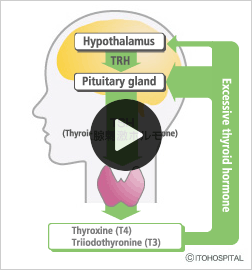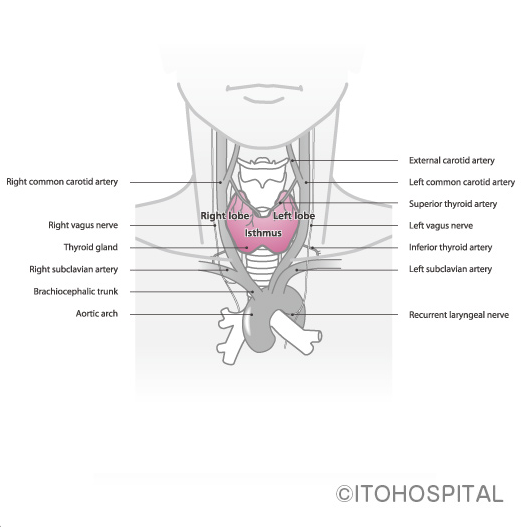Location and size of the thyroid gland
The thyroid is located in the front of the neck just below the Adam’s apple. The thyroid is shaped like a butterfly with its wings spread, and it wraps around the trachea. From top to bottom, the thyroid is about 4 centimeters and weighs less than 20 grams. It is a thin and soft organ. If there is no swelling, the thyroid is difficult to locate by touch. However, if it swells slightly, you will be able feel it with your fingers. If the thyroid becomes larger, the swelling can be identified visually.
Thyroid Function
Various types of hormones are produced in the human body, such as estrogens, androgens, and corticosteroids. Organs that produce hormones are called endocrine organs. The thyroid is an endocrine organ and functions to produce thyroid hormones made from iodine contained in food (primarily seaweed).
What are thyroid hormones?
Proteins, fats, and carbohydrates consumed in food are metabolized and used as materials to make tissues and as sources of energy for the body to move. Thyroid hormones stimulate and facilitate these metabolic processes. In addition, thyroid hormones also play an important role in fetal development and childhood growth. There are two types of thyroid hormones: thyroxine (T4) and triiodothyronine (T3). T4 contains four iodine atoms while T3 contains three iodine atoms. The thyroid primarily synthesizes T4. When T4 is converted into T3 in the liver, it becomes an activated hormone. Most T4 and T3 are attached to proteins in the blood. The thyroid hormones that have effects on the body are free T4 (FT4) and free T3 (FT3), which are not attached to proteins. Blood tests can confirm the amounts these hormones.
The role of the pituitary gland
The body has a mechanism for maintaining stable thyroid hormone levels in the blood. This mechanism is controlled by thyroid-stimulating hormone (TSH) which is secreted by the pituitary gland at the base of the brain. TSH works to stimulate the thyroid and promote the secretion of thyroid hormones T4 and T3. When thyroid hormones (T4 and T3) are in excess in the bloodstream, TSH secretion from the pituitary gland is suppressed, thereby reducing the secretion of T4 and T3. In contrast, when blood levels of T4 and T3 are low, TSH secretion increases to promote the secretion of T4 and T3. This feedback mechanism maintains T4 and T3 levels within a proper range.

